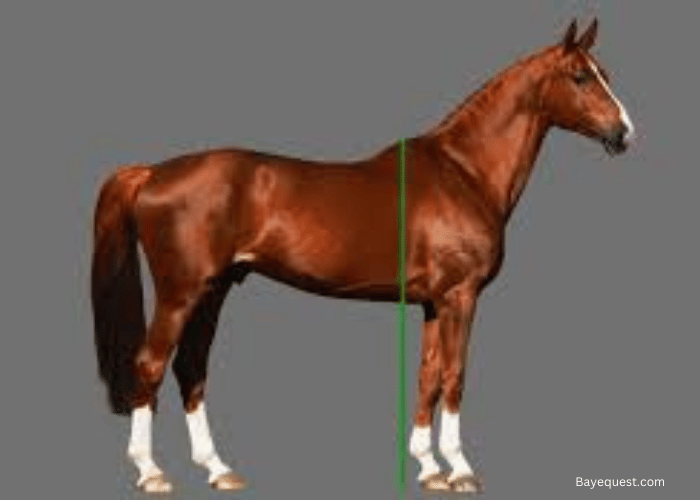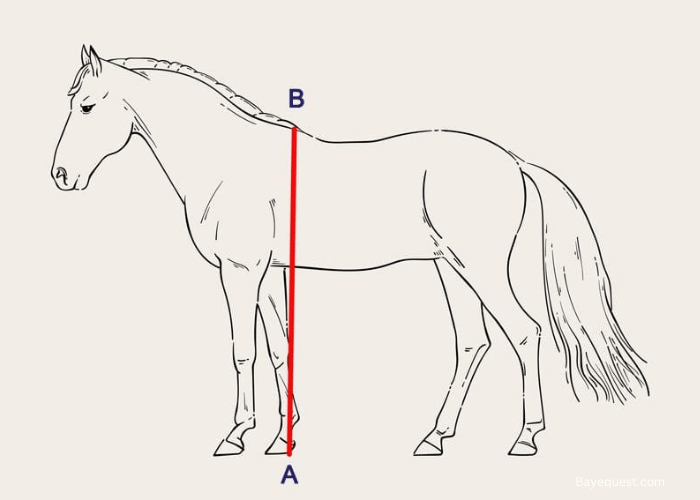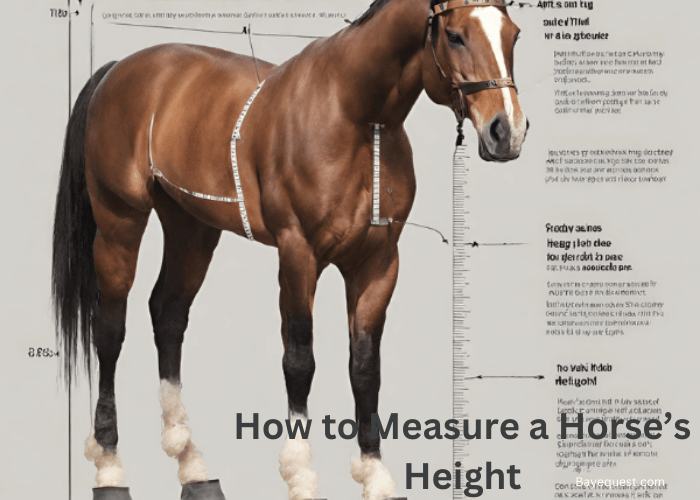Did you know that horses are measured not in feet or meters but in ‘hands’? Whether you’re a seasoned equestrian or a curious newbie, knowing how to measure a horse’s height accurately is essential.
This article leverages years of equine expertise to simplify the process, ensuring precise and professional measurements. From identifying the correct tools to understanding the ‘hands’ system, we’ll guide you through each step.
Let’s get started on making your horse measurements a breeze.
How to Measure a Horse’s Height – Key Takeaway
To measure a horse’s height, use a measuring stick or tape to measure from the ground to the highest point of the withers, the ridge between the shoulder blades. This ensures an accurate height in ‘hands,’ the standard unit. Knowing this method helps in understanding a horse’s true height and health.
How Tall is the Average Horse?
The average horse stands between 15 to 16 hands tall, translating to about 5 to 5.5 feet at the shoulder. However, height varies by breed. Ponies, for example, are under 14.2 hands, while draft horses can exceed 17 hands.
This range helps to categorize horses for different roles, from riding to heavy labor. Knowing the average height helps in selecting the right horse for your needs, whether for riding, showing, or work.
Understanding these differences in height can give you a clearer idea of what to expect when you’re around different breeds of horses.
Why are Horses Measured in Hands?
Horses are measured in hands because it’s a simple, old method that’s still useful today. A ‘hand’ is four inches, roughly the width of a human hand.
This system started when rulers and tape measures weren’t available. People used what they had: their hands.
Measuring in hands remains convenient and helps everyone understand a horse’s height easily. It’s consistent and traditional, so it’s used worldwide.
This method allows for quick comparisons between horses. Whether you’re at a stable or a horse show, saying a horse is ’16 hands’ is clear and universally understood. It keeps things straightforward.

How to Measure a Horse in Hands
One hand is equal to four inches. When measuring horses in hands, decimals are used for partial measurements. For example, a horse that is 14.2 hands is 14 hands plus 2 inches, which is 58 inches in total: (14 x 4) + 2.
A horse can’t be 14.5 hands, because the number after the decimal represents whole inches, not fractions. If a horse is 14.2 1/2 HH, it means he is two and a half inches over 14 hands.
Horses are measured from the ground, just beside and behind a foreleg, to the top of the withers (shoulders).
The withers is a part of the horse that doesn’t change height when the horse moves its head or back. This is the standard place to measure a horse’s height.
This method is used no matter what measurement unit you use (hands or centimetres), what country you’re in, what type of riding you do, or what breed of horse or pony you have.
Tools for Measuring a Horse’s Height
To measure a horse’s height, you can use several tools:
Equine Height Measuring Stick
This is the most accurate and easiest method. It’s a tall stick with inch measurements and a horizontal bar that slides up and down.
You place the stick beside the horse and slide the bar down to touch the horse’s withers. Some sticks have a leveling bubble to ensure it’s held level.
Height Tapes
These can be bought at feed or tack stores. They’re inexpensive but can be tricky to use because they’re light and floppy.
You need one person to hold the bottom against the ground and another to read the measurement at the horse’s withers. The tape must stay perpendicular to the ground.
Often, these tapes also have a horse weight measure on the other side.
Regular Tape Measure
You can use a regular tape measure, but it has the same issues as height tapes. Metal tape measures can also make noise, which might make the horse move.
Homemade Measuring Device
A simple method is to tie a piece of binder twine to a large metal nut or washer. The weight keeps the string steady while you eye up the withers and mark the twine with a marker.
Then measure the length from the bottom of the washer to the mark on the twine. To make it easier, you can use a yardstick, piece of lath, or even a whip to get a line from the twine to the withers.
Hold the yardstick so it sits on the horse’s withers, parallel to the ground, and note where it hits the tape.
How are Horses Measured
To measure your horse, make sure it stands square on a flat surface. Hold the measuring tape or stick straight up and down, next to the horse, lined up with the highest point of the horse’s withers.
If you’re using a measuring stick with a bar, lower the bar until it touches the top of the withers. Record the measurement. If you’re measuring in inches, divide the total inches by 4 to get the hands, and the leftover inches are the decimals.
For example, 62 inches is 15 hands and 2 inches, or 15.2 HH.
If you’re measuring for competitions that separate horses and ponies, you might need to consider horseshoes.
Shoes can make a pony exceed the height limit, so check if there’s an allowance for shod ponies. If you need a horse of a specific height or need to verify its height for a competition, find out if the measurement should include the shoes.

Horse Height Hands Conversion Chart
To help you better understand how hands convert to our traditional units of measurement, here’s a handy conversion chart I put together.
| Hands | Inches | Feet | Meters |
| 12.0 | 48 | 4ft 0in | 1.2192 |
| 12.1 | 49 | 4ft 1in | 1.2446 |
| 12.2 | 50 | 4ft 2in | 1.27 |
| 12.3 | 51 | 4ft 3in | 1.2954 |
| 13.0 | 52 | 4ft 4in | 1.3208 |
| 13.1 | 53 | 4ft 5in | 1.3462 |
| 13.2 | 54 | 4ft 6in | 1.371 |
| 13.3 | 55 | 4ft 7in | 1.397 |
| 14.0 | 56 | 4ft 8in | 1.4224 |
| 14.1 | 57 | 4ft 9in | 1.4478 |
| 14.2 | 58 | 4ft 10in | 1.4732 |
| 14.3 | 59 | 4ft 11in | 1.4986 |
| 15.0 | 60 | 5ft 0in | 1.524 |
| 15.1 | 61 | 5ft 1in | 1.5494 |
| 15.2 | 62 | 5ft 2in | 1.5748 |
| 15.3 | 63 | 5ft 3in | 1.6002 |
| 16.0 | 64 | 5ft 4in | 1.6256 |
| 16.1 | 65 | 5ft 5in | 1.651 |
| 16.2 | 66 | 5ft 6in | 1.6764 |
| 16.3 | 67 | 5ft 7in | 1.7018 |
| 17.0 | 68 | 5ft 8in | 1.7272 |
| 17.1 | 69 | 5ft 9in | 1.7526 |
| 17.2 | 70 | 5ft 10in | 1.778 |
| 17.3 | 71 | 5ft 11in | 1.803 |
| 18.0 | 72 | 6ft 0in | 1.8288 |
FAQs
When Do Horses Reach Their Full Height?
Most horse breeds reach their full height when they are about four or five years old. After that, they might get a bit wider or fill out for another 2 to 3 years. Draft horses and mixed breeds might keep growing until they are eight years old.
How Can You Predict a Horse’s Height When They’re Young?
There’s no way to know for sure how tall a horse will be when it’s fully grown, but there are some clues. Most of a horse’s growth happens in the first year. By 12 months old, horses have reached about 90 percent of their full height. So, how tall your horse is at 12 months old can give you a good idea if they’ll be short or tall.
Related read: When Do Horses Stop Growing?
What Height Horse Should I Ride?
Height isn’t a big deal when choosing a horse. If you’re shorter but feel good on a taller horse, that’s okay. But, tall horses can be hard to get on without a mounting block. When picking a horse, it’s more important to think about how much weight the horse can carry comfortably.
How tall is 14 hands on a horse?
A horse that is 14 hands tall measures 56 inches or 142.24 centimeters in height. The term “hand” is a traditional unit of measurement in equestrian contexts, with one hand equaling 4 inches or 10.16 centimeters. This measurement is taken from the ground to the horse’s withers, the highest point of its back at the base of the neck.
Conclusion
When you’re measuring a horse, getting it right matters a lot. It tells you if the horse fits the bill for certain jobs, helps with feeding right, and ensures the gear fits well. You’ll want to use a stick made for this or a measuring tape.
Measure straight up from the ground to the withers—that’s the high spot right at the base of the horse’s neck. Make sure your horse stands even and level.
This way, you measure accurately. Getting good at this helps you take the best care of your horse, knowing exactly how tall it stands.
What next? Check out our article on Jockey Weight and Height to learn how a jockey’s size complements the horse’s build for peak performance.








